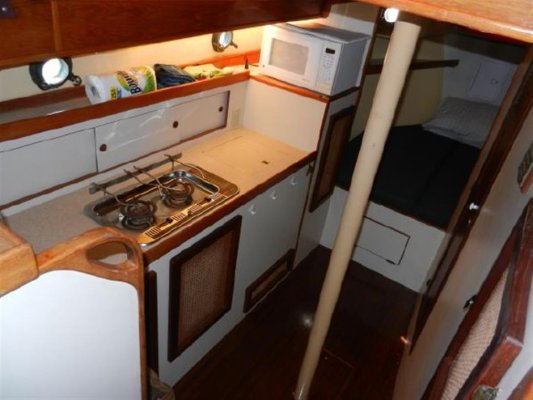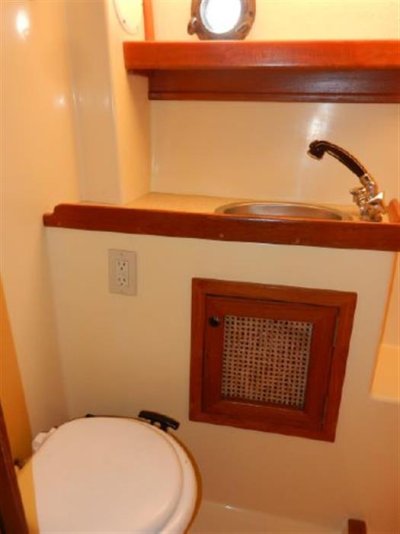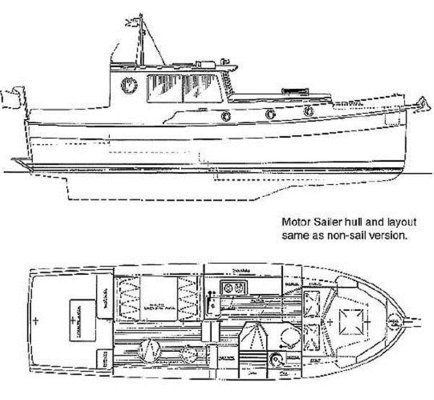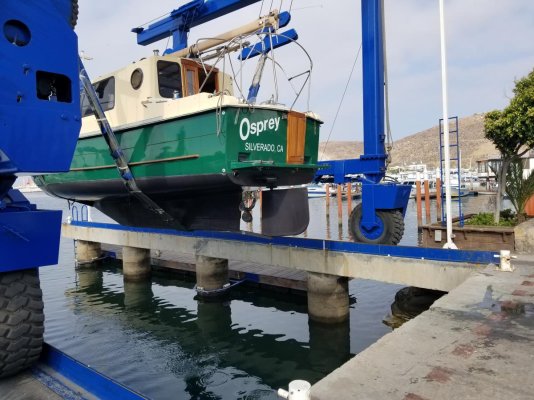Osprey Update
I'm overdue to post an update on Osprey. So here is a quick summary of what I've done. After I bought Osprey, I had the trailer overhauled (repacked the bearings, and replaced the lights, wiring, and tires). Then I hired a truck driver to trailer her to Southern California. Once the boat arrived, I learned the tongue jack was worn out, so I replaced that. Once I finally got the trailer registered in California (it turned out the previous owner provided a color photocopy of the trailer title, which the CA DMV wouldn't accept). I trailered her to Baja Naval in Enseneda Mexico.
The trip to Ensenada was memorable. When you take a boat into Mexico you have to get a temporary import permit (TIP). I researched this and ensured I had all the necessary documentation, but when I handed over the USCG Documentation, they looked like they had never seen one and said they didn't know what to do with it. Turns out every trailerable boat they have seen had state registration, not USCG Documentation. We were required to park the truck and trailer on a special platform while a moving scanner X-rayed(?) our vehicle see photo. It was a little tight but it fit because it is a legal size load. We were delayed for ~2.5 hours while they called in a different border guard. She stared at it for a while and finally called someone who walked her through the process of filling out the form. Once we cleared the border, we had to rush to get to the boatyard before they closed because we didn't have anywhere to secure Osprey overnight. I guess it always pays to have a backup plan and a flexible schedule.
I was very satisfied with the work I had Baja Naval perform. The quality of their work was good and their labor rates were ~1/3 of my local Shipyard, so I was extremely happy with the value. With that said, I made the trip to Ensenada Mexico in 2017, but I wouldn't do it today because safety and security South of the border have degraded.
Here is a list of what I had Baja Naval perform in 2017 (in most cases I selected and purchased the hardware and provided it to Baja Naval and they did the installation):
1) Install new Side Power bow and stern thrusters,
2) Install 4 new Concord Lifeline GPL-30HT AGM batteries (two under the steps between the galley and pilothouse, one in the bow under the V-berth, and one in the lazaret),
3) Install Yanmar-approved Balmar serpentine belt and a Balmar 200 amp alternator,
4) Install Magnum 3000W 12VDC Pure Sine Hybrid Inverter Charger and battery monitor,
5) Repaired corrosion damage on the cast iron ballast at the base of the mast,
6) Repaint bottom paint,
7) Strip and refinish external teak,
8) Refresh internal varnish
9) Attach a boarding stair to the swim platform to facilitate boarding while on the trailer,
10) Clean engine compartment.
Bow & Stern Thrusters: IMHO the best modification I made so far. The thrusters make docking, especially in tight quarters very simple and low stress. In addition, Side Power has a hold feature that keeps both thrusters on while you tie up. Allowing me to perform single-handed docking with ease.
Batteries: The GPL-30HT AGM Batteries are a 150 AH capacity. Two of these batteries just barely fit in the battery compartment under the steps. The batteries in the bow and stern power the thrusters with minimal voltage drop. These are connected to the other two batteries with 00 cables, so in float charge, the voltage drop is minimal and all four batteries are effectively a single 600 AH house battery bank. The engine start battery is also a GPL-30HT, so both banks use the same charging profile and it provides over 700 cold-cranking amps at zero degrees F. I have determined that the optimum discharge percentage for these batteries for minimum life cycle cost is 80% not 50% (I'll prove that in a future post), so my usable battery bank capacity is 480 AH.
Alternator upgrade: The Balmar serpentine belt kit is approved by Yanmar and supports up to a 200 amp alternator. It produces about 150 amps at idle and 200 amps while underway.
Inverter/charger: The inverter allows me to run the heater/AC and the water heater (currently I don't have engine water jacket heating) when I'm away from shore power and it provides the proper charging profile for AGM batteries.
The survey discovered corrosion damage at the base of the compression post beneath the mast. I reduced the offer by $2500 and the seller quickly accepted. Baja Naval chipped out all the damaged cement that encapsulate the cast iron ballast. They treated the rusted cast iron and replaced the cement with the required epoxy cement and repainted it so it looks like new for $2400. I'm sure it would have cost 3 times as much in the US.
Boarding Stairs: When Ospery if on the trailer, the swim platform is over five feet off the ground. Since I want my wife to go on trips with me, and we plan to stay onboard while en route (because finding secure overnight parking is very difficult) I need safe and secure boarding. I purchased a New Wave Fabrication Tide Rider Boarding Stair 9-tread boarding stairs with two handrails. I also modified the trailer to allow me to securely mount the stairs on the back of the trailer.
Following all the work at Baja Naval, we put Osprey back on the trailer and brought her home. I decided to cross the border at Otay Mesa border crossing instead of San Ysidro because I didn't like the multi-lane traffic circles in Tiajuana. Turns out Otay Mesa is a bad option for a large trailerable boat. We had ~1.5 inches of clearance on each side, but with the mast, we had negative clearance at the top. We had to back out of the entrance against oncoming traffic and we were directed to the commercial crossing. The commercial crossing was bad advice because all commercial loads have to have a bill of lading form and we didn't have one. We only got across only because a senior border guard fell in love with the boat and he went to each checkpoint to get us through.
 large_1670207.jpg89.3 KB · Views: 316
large_1670207.jpg89.3 KB · Views: 316 large_1032502.jpg68.3 KB · Views: 488
large_1032502.jpg68.3 KB · Views: 488 large_1032501.jpg90.2 KB · Views: 367
large_1032501.jpg90.2 KB · Views: 367 large_1032503.jpg80.7 KB · Views: 296
large_1032503.jpg80.7 KB · Views: 296 large_1032531.jpg76.3 KB · Views: 783
large_1032531.jpg76.3 KB · Views: 783 large_1032504.jpg41.7 KB · Views: 336
large_1032504.jpg41.7 KB · Views: 336 large_1032508.jpg55.9 KB · Views: 301
large_1032508.jpg55.9 KB · Views: 301 large_1032505.jpg58.1 KB · Views: 287
large_1032505.jpg58.1 KB · Views: 287 large_1032509.jpg82.3 KB · Views: 282
large_1032509.jpg82.3 KB · Views: 282 large_1032506.jpg61.8 KB · Views: 333
large_1032506.jpg61.8 KB · Views: 333





























